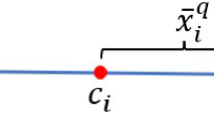Abstract
A new modification to the particle swarm optimization (PSO) algorithm is proposed aiming to make the algorithm less sensitive to selection of the initial search domain. To achieve this goal, we release the boundaries of the search domain and enable each boundary to drift independently, guided by the number of collisions with particles involved in the optimization process. The gradual modification of the active search domain range enables us to prevent particles from revisiting less promising regions of the search domain and also to explore the areas located outside the initial search domain. With time, the search domain shrinks around a region holding a global extremum. This helps improve the quality of the final solution obtained. It also makes the algorithm less sensitive to initial choice of the search domain ranges. The effectiveness of the proposed Floating Boundary PSO (FBPSO) is demonstrated using a set of standard test functions. To control the performance of the algorithm, new parameters are introduced. Their optimal values are determined through numerical examples.
Similar content being viewed by others
References
Eberhart, R.C., Shi Y.: Particle swarm optimization: developments, applications and resources. In: Proc. Congr. Evolutionary Computation. vol. 1, pp. 81–86 (2001)
Parsopoulos K.E., Vrahatis M.N.: Recent approaches to global optimization problems through Particle Swarm Optimization. Nat. Comput. 1, 235–306 (2002)
Clerc M., Kennedy J.: The particle swarm: explosion, stability and convergence in a multi-dimensional complex space. IEEE Trans. Evol. Comput. 6, 58–73 (2002)
Schutte J.F., Groenwold A.A.: A study of global optimization using particle swarms. J. Glob. Optim. 31, 93–108 (2005)
Xu S., Rahmat-Samii Y.: Boundary conditions in particle swarm optimization: revisited. IEEE Trans. Antennas Propag. 55(3), 760–765 (2007)
Hoorfar A.: Evolutionary programming in electromagnetic optimization: a review. IEEE Trans. Antennas Propag. 55(3), 523–537 (2007)
Robinson J., Rahmat-Samii Y.: Particle swarm optimization in electromagnetic. IEEE Trans. Antennas Propag. 52(2), 397–407 (2004)
Boriskin A.V., Sauleau R.: Numerical investigation into the design of shaped dielectric lens antennas with improved angular characteristics. Prog. Electromagn. Res. B 30, 279–292 (2011)
Rolland A., Ettorre M., Boriskin A.V., Le Coq L., Sauleau R.: Axisymmetric resonant lens antenna with improved directivity in Ka-band. IEEE Antennas Wirel. Propag. Lett. 10(1), 37–40 (2011)
Rolland A., Boriskin A.V., Person C., Quendo C., Le Coq L., Sauleau R.: Lens-corrected axis-symmetrical shaped horn antenna in metallized foam with improved bandwidth. IEEE Antennas Wirel. Propag. Lett. 11(1), 57–60 (2012)
Zhan, Z., Xiao, J., Zhang, J., Chen, W.: Adapting control of acceleration coefficients for particle swarm optimization based on clustering analysis. In: Proc. Congr. Evolutionary Computation, pp. 3276–3282 (2007)
Li, C., Yang, S.: An adaptive learning particle swarm optimizer for function optimization. In: Proc. Congr. Evolutionary Computation, pp. 381–388 (2009)
Kitayama S., Yamazaki K., Arakawa M.: Adaptive range particle swarm optimization. Optim. Eng. 10, 575–597 (2009)
Galan, A.Yu., Boryskina, O.P., Sauleau, R., Boriskin, A.V.: Particle swarm optimization algorithm with moving boundaries as a powerful tool for exploration research. In: Proc. 5th Eur. Conf. Antennas Propag. (EuCAP), Rome (Italy), pp. 2081–2084 (2011)
Huang T., Mohan A.S.: A hybrid boundary condition for robust particle swarm optimization. IEEE Antennas Wirel. Propag. Lett. 4, 112–117 (2005)
Galan A.Yu., Sauleau R., Boriskin A.V.: Parameter selection in particle swarm optimization algorithm for synthesis of linear arrays with flat-top beams. J. Telecommun. Radio Eng. 70(16), 1415–1428 (2011)
Author information
Authors and Affiliations
Corresponding author
Rights and permissions
About this article
Cite this article
Galan, A.Y., Sauleau, R. & Boriskin, A.V. Floating boundary particle swarm optimization algorithm. Optim Lett 7, 1261–1280 (2013). https://doi.org/10.1007/s11590-012-0502-8
Received:
Accepted:
Published:
Issue Date:
DOI: https://doi.org/10.1007/s11590-012-0502-8




